Lea Wait's Blog, page 90
May 3, 2022
Win A Book Wednesday: May 4, 2022
Kaitlyn Dunnett/Kathy Lynn Emerson is giving away a print copy of The Valentine Veilleux Mysteries (three short stories and a novella featuring a calendar and pet photographer as the amateur sleuth). To enter, leave a comment after reading Kaitlyn/Kathy’s last blog https://mainecrimewriters.com/2022/05/02/whatever-happened-to-and-a-giveaway/#comments The comment should be left AT THAT POST. A winner will be drawn on May 10 and announced here on May 11.
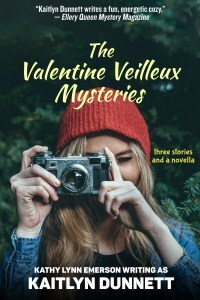
Good luck, everyone.
Sisters in Crime? What the Heck are They?
Kate Flora: In 1993, after nine painful years in the unpublished writer’s corner, I was on  the cusp of publishing my first mystery. Chosen for Death, book one in my Thea Kozak series, was scheduled for publication the following year, and my publisher urged me to attend a national crime writer’s conference to meet other writers and hopefully find some who would be willing to give me cover blurbs for my book.
the cusp of publishing my first mystery. Chosen for Death, book one in my Thea Kozak series, was scheduled for publication the following year, and my publisher urged me to attend a national crime writer’s conference to meet other writers and hopefully find some who would be willing to give me cover blurbs for my book.
Despite being a country mouse, I followed the publisher’s advice and flew to Omaha, Nebraska to attend my first Bouchercon. Feeling a bit like Alice in Wonderland, I wandered around rooms full of authors I’d read and admired, and was given a very important piece of advice: If you’re going to be a woman in the crime writing world, you need to join Sisters in Crime.
At that point, Sisters was seven years old but I had never heard of it. I came back to New England, found our local chapter, and found a home in the wonderful, supportive, and inclusive world that is Sisters in Crime. We formed a speaker’s bureau to get our authors greater recognition. We offered seminars on craft and the world of crime and crime investigation. We built a chapter from a handful of members to over two hundred. We co-founded a regional writing conference, The New England Crime Bake, to bring the crime writing community together.
Among the special values Sisters has given me have been mentors who showed me how to do author talks, contact experts who could give advice on particular issues in books I was writing, such as details for a scuba diving scene, and perhaps most valuable, since the publishing world can be so harsh, support in the face of rejection.

I do an autopsy with Lea Wait and Tess Gerritsen
A bit about Sisters in Crime:
No, we are not cops. No, we are not criminals. And no, we are not a gang of criminal nuns. What we are is an international group of writers who came together, initially, to combat the sexism and stereotyping that was common in the crime writing field back then. We’ve stayed together because we know that networking and support are things women do well. At a conference in Chicago about a decade ago, as we revisited our mission and looked to the future, we came up with a motto that beautifully summarized the value of Sisters in individual writer’s lives:
You write alone but you’re not alone
Through advocacy, education, our continuing monitoring project, and expansion of our support beyond novels to short stories, Sisters in Crime provides a wonderful home for writers who are looking for education, answers, and community.
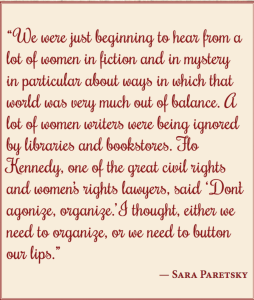
Sisters in Crime was founded in 1986 to promote the ongoing advancement, recognition and professional development of women crime writers.
Back in 1986, twenty-six women crime writers, frustrated with the obstacles they faced in publishing, met at the Bouchercon World Mystery Convention in Baltimore to plot a path toward being treated as the equals of male writers. They gathered again in May 1987 during the Edgar Awards Week in New York to formally establish the organization, Sisters in Crime (SinC). The group formed a steering committee and held the first membership meeting at Bouchercon in 1987, establishing a tradition that continues.
At the time, although perhaps (Kate’s stats, not SinC’s) thirty percent of crime novels were written by women, the statistics on reviews and attention to those books were appalling. The attitude seemed to be that only women read women’s books, and women bought those books with their “pin money” so giving the books review attention, even though it was through reviews that books were brought to readers and book seller’s attention, was a waste of time. The SinC monitoring project began to collect those statistics, bring them to the attention of publishers, reviewers and publications, and attention to women’s books began to improve.
https://www.sistersincrime.org/page/ABOUT
A lot of great educational videos about craft here:
https://www.youtube.com/channel/UCqLdMJuvE_K7ddw87fyVBpg
A History of Sisters in Crime: http://homepages.gac.edu/~fister/SinCPCA.pdf
Information about the New England chapter here: https://sincne.clubexpress.com
May 1, 2022
Whatever Happened to . . . (and a giveaway)
 Kaitlyn Dunnett/Kathy Lynn Emerson here. I’m not sure what got me started on this topic, but I’ve been thinking lately about the various protagonists I’ve created over the years and speculating about what might have happened to them after their respective series came to an end.
Kaitlyn Dunnett/Kathy Lynn Emerson here. I’m not sure what got me started on this topic, but I’ve been thinking lately about the various protagonists I’ve created over the years and speculating about what might have happened to them after their respective series came to an end.
I can remember quite clearly my reaction to learning that St. Martin’s Press had decided, after seven books, not to continue publishing my Face Down series featuring Susanna, Lady Appleton, sixteenth-century gentlewoman, expert on poisonous herbs, and amateur sleuth. I had a lot more I wanted to do with that character and was determined not to abandon her. I ended up writing three more Face Down novels and numerous short stories featuring Susanna and her friends and she also appears in the second book of my spin-off Mistress Jaffrey Mysteries. What happened to her after 1586 (“Lady Appleton and the Yuletide Hogglers,” included in Volume Three of The Face Down Collection). As I imagine it, she’s living comfortably at Leigh Abbey, her home in Kent, devoting herself to local concerns and taking care of her long-time companion, Jennet, who has a dicey heart. She’s been reconciled with her adopted daughter, Rosamond, and there’s a prospect of grandchildren in her future by way of Rosamond and her no-longer-estranged husband, Rob, Jennet’s son.
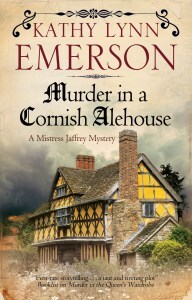 Will I ever write more Lady Appleton stories? Probably not. I’ve already done prequels (included in Volume One of The Face Down Collection), and frankly, by sixteenth-century standards, now in her mid-fifties, she’s getting a little long in the tooth to gad about solving crimes. Mid-fifties in those days would be equivalent to mid-eighties today. As for Rosamond and Rob, the third of their adventures (Murder in a Cornish Alehouse) left them happily returning home to London and responsible for Rosamond’s young half brother’s well-being. I didn’t actually say so, but in my mind, Rosamond was already pregnant. Raising a family should keep her too busy to meddle in more murders.
Will I ever write more Lady Appleton stories? Probably not. I’ve already done prequels (included in Volume One of The Face Down Collection), and frankly, by sixteenth-century standards, now in her mid-fifties, she’s getting a little long in the tooth to gad about solving crimes. Mid-fifties in those days would be equivalent to mid-eighties today. As for Rosamond and Rob, the third of their adventures (Murder in a Cornish Alehouse) left them happily returning home to London and responsible for Rosamond’s young half brother’s well-being. I didn’t actually say so, but in my mind, Rosamond was already pregnant. Raising a family should keep her too busy to meddle in more murders.
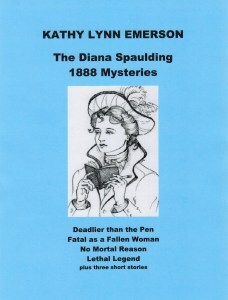 How do I know Rosamond had children? Because my other historical mystery series, the Diana Spaulding 1888 Quartet (soon to be released in an omnibus e-book edition), mentions that she’s descended from a famous sixteenth-century herbalist. Given the passage of several centuries, her knowledge of her own ancestry isn’t precisely accurate. Since Susanna had no children of her own, it’s her adopted daughter, Rosamond, from whom Diana is descended. Rosamond and Rob’s first child, Andrew, is Diana’s ancestor.
How do I know Rosamond had children? Because my other historical mystery series, the Diana Spaulding 1888 Quartet (soon to be released in an omnibus e-book edition), mentions that she’s descended from a famous sixteenth-century herbalist. Given the passage of several centuries, her knowledge of her own ancestry isn’t precisely accurate. Since Susanna had no children of her own, it’s her adopted daughter, Rosamond, from whom Diana is descended. Rosamond and Rob’s first child, Andrew, is Diana’s ancestor.
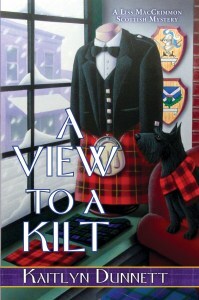 Similarly, the protagonists of my two contemporary mystery series have lives that continue after the final book. In the thirteenth Liss MacCrimmon Mystery, A View to a Kilt, Liss is left contemplating two possibilities for her future. One is a career as a professional investigator. The other is a partnership of some unspecified nature with her mother, with whom she has gradually developed a working relationship after years of antagonism. Either way, I don’t see children in her future, but I do see her continuing to live in Moosetookalook, Maine with her husband, family, and friends, and staying involved in community activities. She and her mother will continue to work at understanding and accepting each other. They may even succeed.
Similarly, the protagonists of my two contemporary mystery series have lives that continue after the final book. In the thirteenth Liss MacCrimmon Mystery, A View to a Kilt, Liss is left contemplating two possibilities for her future. One is a career as a professional investigator. The other is a partnership of some unspecified nature with her mother, with whom she has gradually developed a working relationship after years of antagonism. Either way, I don’t see children in her future, but I do see her continuing to live in Moosetookalook, Maine with her husband, family, and friends, and staying involved in community activities. She and her mother will continue to work at understanding and accepting each other. They may even succeed.
I had made a few notes for a fourteenth book, dealing with nefarious doings surrounding the construction of senior citizens’ housing on the site of the mansion that figured in two previous entries in the series (particularly in the Halloween book, Vampires, Bones, and Treacle Scones), but it didn’t have much in the way of an original plot. After seventy books, most of them novels, I ran a very real risk of repeating myself. Lacking enough of an idea to inspire 75,000+ words in a series my publisher no longer wanted. I realized Liss was in a good place in her life at the end of book thirteen and decided to leave her there.
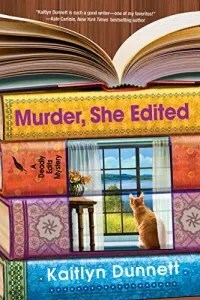 As for Mikki Lincoln, you might think that since she’s in her seventies, she doesn’t have that much of a future left. I beg to differ. Although she and her friend Darlene have certain physical limitations due to their age, they still have their wits about them and, unlike Susanna Appleton, have the benefits of modern medicine to help them deal with the downside of getting older.
As for Mikki Lincoln, you might think that since she’s in her seventies, she doesn’t have that much of a future left. I beg to differ. Although she and her friend Darlene have certain physical limitations due to their age, they still have their wits about them and, unlike Susanna Appleton, have the benefits of modern medicine to help them deal with the downside of getting older.
One of the things negative reviews have noted is Mikki’s tendency toward indulging in nostalgia, particularly when she shares memories from her teen years, That was when she last lived in the village of Lenape Hollow, New York. Looking back was deliberate on my part, since she reconnects with both an old friend and an old enemy (the classic “mean girl” from high school) and those relationships were slated to grow and change in the course of the series. Did I have plans for another book after number four? Not really. I pretty much did all I wanted to do with those characters. I envision them continuing to live and work together for at least another decade, enjoying both their present-day activities and the occasional fond recollection of years gone by. I can personally vouch for the fact that when one passes the age of seventy, memories from fifty-plus years earlier are often more vivid than those of the recent past.
So there you are, the “where are they now?” for my sleuths. I’d love to hear what readers think of those fictional futures. And, if you leave a comment, you’ll be entered to win a print copy of The Valentine Veilleux Mysteries, the one bit of “new” writing I’ve done since completing Murder, She Edited (written pre-covid and published in 2021). A drawing for the winner will take place on May 10.

Kathy Lynn Emerson/Kaitlyn Dunnett has had sixty-four books traditionally published and has self published others, including several children’s books. She won the Agatha Award and was an Anthony and Macavity finalist for best mystery nonfiction of 2008 for How to Write Killer Historical Mysteries and was an Agatha Award finalist in 2015 in the best mystery short story category. She was the Malice Domestic Guest of Honor in 2014. Her most recent publications are The Valentine Veilleux Mysteries (a collection of three short stories and a novella, written as Kaitlyn) and I Kill People for a Living: A Collection of Essays by a Writer of Cozy Mysteries (written as Kathy). She maintains websites at www.KaitlynDunnett.com and www.KathyLynnEmerson.com. A third, at A Who’s Who of Tudor Women, is the gateway to over 2300 mini-biographies of sixteenth-century Englishwomen.
April 29, 2022
Weekend Update: April 30-May 1, 2022
 Next week at Maine Crime Writers there will be a posts by Kaitlyn Dunnett/Kathy Lynn Emerson (Monday) Kate Flora (Tuesday), John Clark (Thursday) and Brenda Buchanan (Friday).
Next week at Maine Crime Writers there will be a posts by Kaitlyn Dunnett/Kathy Lynn Emerson (Monday) Kate Flora (Tuesday), John Clark (Thursday) and Brenda Buchanan (Friday).
In the news department, here’s what’s happening with some of us who blog regularly at Maine Crime Writers:
If you want a copy of the poster below in .pdf send an email to songthresher@gmail.com

An invitation to readers of this blog: Do you have news relating to Maine, Crime, or Writing? We’d love to hear from you. Just comment below to share.
And a reminder: If your library, school, or organization is looking for a speaker, we are often available to talk about the writing process, research, where we get our ideas, and other mysteries of the business. We also do programs on Zoom. Contact Kate Flora
April 28, 2022
Walking Geese Sound Like Old Men
The news from Trout Brook is good: the rhubarb is leafing out, the radish tops have broken the surface of the dirt, the lilacs and forsythia are budding. I noticed on my walk through Jordan’s Farm the other morning that walking geese  don’t honk, but make a noise in their throats that sounds like old men farting. More on that later. The world is liminal at this moment in the year—it was sixty degrees yesterday and thirty-one this morning—but the balance is starting to tip toward spring and warmth and growth. We welcome it.
don’t honk, but make a noise in their throats that sounds like old men farting. More on that later. The world is liminal at this moment in the year—it was sixty degrees yesterday and thirty-one this morning—but the balance is starting to tip toward spring and warmth and growth. We welcome it.
In the pandemic times, when I’ve been cautious about spending much time in the gym, wheezing and coughing with the other (mostly unmasked) types. I’ve done much more working out at home. One of the great benefits of this has been introducing myself to the podcast world and listening to various intelligent and entertaining voices.
I know Terry Gross, of course—it’s just that I don’t listen to the radio as much, since I don’t have the hour-long drives that characterized my commuting life. Fresh Air is available as a podcast and I’ve started tuning it in while I’m fake-skiing on my Concept II.
Most recently, listening to Delia Ephron talk about her new book Left on Tenth,  I heard her toss off a sentence that stopped me in my tracks—literally. “Writing is your fingerprint.”
I heard her toss off a sentence that stopped me in my tracks—literally. “Writing is your fingerprint.”
Fingerprints are unique. No one else in the world has the same set of ridges and whorls, not even a twin, if you have one. Ephron’s pronouncement struck me as an almost perfect metaphor for what a writer does, especially a writer following his or her nose and not trying to write to a market or a trend.
Writing will not let you disguise who you are. (We’re not talking about your penmanship here.) The words and phrases you habitually use, your tone of voice, how you describe people and objects, all identify you. They are unique to your perspective on the world. The rhythm of your writing is a history of where you’ve been, a guess at where you are, a hint at where you want to be.
Many of us start out writing in a style that imitates another writer, usually someone whose prose or poetry we admire. But if you stick with the discipline long enough, you learn that you are trying to speak your own stories, not theirs, and the styles you’ve tried to imitate become subsumed in your own style, unique as, well, a fingerprint.
Which for no rational reason reminded me of a quote from Kurt Vonnegut, which seems apposite in these parlous times: “We are put on earth to fart around, don’t let anyone tell you any different.”
If spring (and eventually, summer) is not a time for farting around, I don’t know what is. But we keep working, don’t we, and we often don’t do enough farting around while working, by which I mean loosening the brain-reins, letting the story flow from where you dream, riding the wave rather than trying to control it.
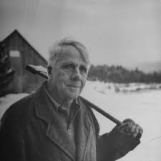 Robert Frost’s Two Tramps in Mud Time says it clearly (and yes, folks, it is still mud time, even if your roads are paved):
Robert Frost’s Two Tramps in Mud Time says it clearly (and yes, folks, it is still mud time, even if your roads are paved):
Only where love and need are one,
And the work is play for mortal stakes
Is the deed ever really done
We may be playing for mortal stakes, but for the best writing we do, the work becomes play, becomes farting around in the best possible sense of the word. So forgive me my crudities, my friends, but fart on. Fart on.
Don’t be afraid of the nuts and bolts of writing
I was giving an author talk a couple years ago, answering the usual questions about my process, when I got an odd response: “Isn’t that cheating?”
I was, if I remember right, describing how I used a big calendar to keep my timeline correct and a large whiteboard to keep my plot sorted out. My answer to the person? Something to the effct of: “When you’re writing a book, the only ‘cheating’ is plagiarizing. Nothing else that gets the book from your head to the page and results in a completed manuscript is off the table.”
He seemed disappointed, looking to catch me in a gotcha moment, I expect. The inner me wanted to say, “Okay Pal, how is YOUR book coming along?” But I didn’t. 
I’ve thought about that exchange a lot since. I find readers are very interested in the writing process, and they’re usually accepting of mine, even if it confuses them. And I find it often does confuse them. My guess is that non-writers and maybe even aspiring writers are spoiled by what they see on TV or in the movies. They see Castle or some other fake writer merrily typing away in an unnaturally clean home or apartment, or some rustic, yet well-appointed, hideway. There are no legal pads scattered around, no other sign the person is writing a book, just the writer and the keyboard and a look of satisfied accomplishment on their smug fake writer face.
Today we’ll talk about reality. At least my reality. Every writer has a different process, which is the first thing to keep in mind. You may hear it all the time, so remember it: there is no “right way” to do this. As far as mine goes, I don’t recommend trying it at home, kids. Unless it works for you.
Before we start, let’s discuss the “works for you” aspect and get it out of the way. I was delayed by months starting my second Bernadette “Bernie” O’Dea mystery, NO NEWS IS BAD NEWS, because I’d decided to try Srivener. I know that people have had wild success with it, so I’m not knocking the product. But for me, not so much. In theory it sounded great — it helps you outline, sort out plot, characters, etc. But I could never untangle it and it kept me from writing as I tried to work within its confusing vortex. I even got a used copy of “Scrivener for Dummies,” but it didn’t help. I guess there’s some circle of dummy below the average dummy that I burn in. Again, this isn’t a knock on Scrivener — I know some people love it. Keep in mind as you read this that we’re talking about my process, and every process is different.
I tried Dabble with the book I’m working on now. I liked it in a lot of ways, it was kind of a much simpler Scrivener. A spunky, friendly hard-working tool. And I did squeeze out about 115,000 words. But when it came time for what I call the “forming the book out of the clay” part (sometimes that part has more bad words, but that’s the basic idea and a blog post for another day), I converted it to good old Microsoft Word and ended my $10 a month subscription. I’d tried, but failed, to use the plot cards, outlining, etc., that seemed so great in theory.
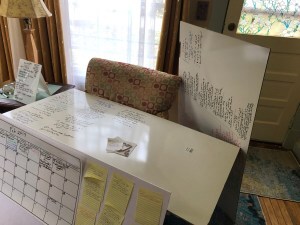
The writing process can be more than just a keyboard.
So, what DO I do, you may ask?
Over three books, now on the fourth, I’ve refined my system to a well-oiled process. I’ll break down the tools (keeping in mind that the computer and brain are the most important parts and should not be discounted):
Massive amount of dry erase markers in as many colors as possible (more on this as we go).Large generic month vinyl sticky calendar page — This is essential to keeping the timeline straight. Don’t you hate it when you’re reading a book and the days don’t match up? “Wait! I thought that happened Sunday! But she’s saying yesterday and now it’s Thursday!” Bang! The book hits the wall across the room, flung by you because you now can’t focus on what’s happening because you’re distracted by the time mixup. I try not to get too detailed — I put important plot points and other happenings, and, when needed color-code them (more on the color coding later). Also, while I know it’s a good idea to not be specific about a year, I use a year when I’m outlining the plot so that the calendar makes sense. All of my books have had specific years for good reasons. In the one I’m writing now, there are things that happened 11 or 12 years before that the protagonist can’t find online because it’s before newspapers were putting everything online, and it has to match the ages of people in the book. Please don’t try to talk me out of it. I’ve given it a lot of thought. Someday I do hope to write a book without a specific year (another blog post for another day). But I digress.Giant piece of poster board. This is to stick the vinyal calendar sheet to, as well as the post-its …Post-It’s. I like the rather large ones that look like little legal pads. I write down thoughts, themes, things I have to add and anything else that I need to remember, and stick them to the poster board. I also like the the smaller multi-colored ones that I use for a variety of more specific things, like a plot thread (green for one, pink for another, etc.) and either stick them to the calendar, or the outline, which we’ll talk about later.Legal pads. I have these by my bed, in the bathroom, on the coffee table by the TV, even one in my car, so when I get an idea, a snatch of dialogue, a plot twist, whatever, I write it down immediately because I’ve learned the hard way I’ll forget it if I don’t. I was gratified to learn, watching “A Very British Murder,” on Brit Box last night that Agatha Christie did the same thing, only with composition books. Yes! (By the way, if you have Brit Box or want to spring $6.99 for a month’s subscription, I highly recommend this three-part documentary, in which British historian Lucy Worsley dissects how the public’s interest in murder grew over three centuries in Britain, and how it influenced mystery writing).Giant whiteboard panels. I was gratified to learn that rather than spend several month’s worth of Gifford Ice Cream money on a whiteboard at Staples, you can buy 3-by-4 foot whiteboard panels for less than $10 at Lowes or Home Depot, in the lumber department. If they get too dirty and you can’t clean them, they’ve served their purpose very inexpensively. I usually use one for a plot outline, which is an organic thing that changes frequently (that’s why I need a whiteboard!) Usually, when I start a book, I have an idea of where it’s going, but if I try to plot it out in detail, I get bogged down and discouraged. So, I write and outline and write and outline. The outline is more to keep track of what’s happened than to plot out what will happen. And here’s where the different colors come in — the outline starts out in black, but as I go through the book (over and over, folks!) I sort it out in color for plot, sub plot, character development, big happenings, etc. This helps me “see” the book in several ways that you can’t see by looking at a doc on the computer.I also, when I am in my first drafts, make every scene a chapter. This allows me to just focus on the story as it’s coming out of my head. Structuring those “chapters” into scenes, generally three to a chapter, comes much later.
I use a second one to write down themes related to characters, or some other major thinga I need to eep in mind. Both whiteboards, along with the big poster board with the calendar, are displayed around my living room, or wherever I’m writing, so that I can glance up and see stuff instead of having to click somewhere or rifle through papers. My cats love it, by the way! More places for them to hide.Little glass easel board. I was so thrilled to find these glass easel boards,made by Quartz, at Staples a couple years ago! First of all, they’re green and I love colored glass. But also, they’re a nice alternative to a whiteboard if you are changing what’s on them daily (or more often), because they don’t get all grungy with repeated use. I use mine to plot out my ever-changing daily schedule. Sometimes it’s all the things I have to do that day, including The Book. Sometimes it’s what I want to accomplish in the book.Microsoft Word. It’s got everything I need, where I want it. No Google docs (good for sharing with others, bad bad bad for writing, rewriting, revising and editing). No fancy software. You can do what you want with Word. I’ve been using it since it was Work (I think? Or whatever it was).Brain, imagination and keyboard. None of the other things work well, if you don’t focus on what’s important — writing the book you want to write.
When I talk to people who are just beginning to write, or who “want to write,” that they often seem bogged down in the how. Some of that, I believe, is that they’re looking for a shortcut to make it “easy.” It’s not a how, it’s a what. It’s writing. There’s no “easy,” just things that are specific to you that will get it from your brain to a completed manuscript with the least amount of pain, confusion and suffering.
I didn’t plan the writer’s helpers outlined above, and wouldn’t have dreamed of them when I started writing my first book. They’re just what evolved as I wrote and began to understand what I needed to keep the ball rolling and keep it all sorted out.
I’ll channel the great Stephen King, who in his book “On Writing” makes the point that what you really need to do is just sit down and write.
April 25, 2022
Fiction Does Truth … Better
“Fiction reveals truth that reality obscures.”
Ralph Waldo Emerson
“There is no doubt fiction makes a better job of the truth.”
Doris Lessing
“Fiction is the lie that tells the truth.” (From “Truth in Fiction: 3 Lessons from Neil Gaiman on Storytelling”)
***********
Fiction has a storied record of taking readers deep into issues and lives and tragedies.  The truths in Uncle Tom’s Cabin and The Jungle and countless works of fiction peel away what lies hidden and what people have tried to hide.
The truths in Uncle Tom’s Cabin and The Jungle and countless works of fiction peel away what lies hidden and what people have tried to hide.
Many, many current mysteries, even the cozies that we love, take us on issue field trips we need to take. Like these:
A Child Shall Lead Them by Maine Crime Writers author, Kate Flora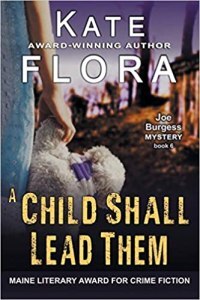
When a jogger discovers the brutalized body of a young girl along a park trail, the ever cranky and relentless, Detective Joe Burgess catches the case.
With the body lacking head and hands, Burgess and his team face complex challenges as they follow a confusing trail leading to human traffickers exploiting children coming to America as asylum seekers.
As Joe and his team race the clock to identify the dead girl in time to save other victims, Joe’s own niece falls into the hands of the sex traffickers. For detectives hell-bent on finding a killer and busting a trafficking ring . . . it just got personal.
A Real Issue: Surviving ‘The Life’: Maine a ‘source state’ for sex traffickers | newscentermaine.com
 Clammed Up by Barbara Ross It’s summertime in Busman’s Harbor, Maine, and the clamming is easy—or it was until a mysterious new neighbor blocks access to the beach, cutting off the Snowden Family Clambake’s supply. Julia Snowden is just one of many townspeople angered by Bartholomew Frick’s decision. But which one of them was angry enough to kill?
Clammed Up by Barbara Ross It’s summertime in Busman’s Harbor, Maine, and the clamming is easy—or it was until a mysterious new neighbor blocks access to the beach, cutting off the Snowden Family Clambake’s supply. Julia Snowden is just one of many townspeople angered by Bartholomew Frick’s decision. But which one of them was angry enough to kill?
Beachcombers, lighthouse buffs, and clammers are outraged after Frick puts up a gate in front of his newly inherited mansion. When Julia urges him to reconsider, she’s the last to see him alive—except the person who stabs him in the neck with a clam rake. As she pores through a long list of suspects, Julia meets disgruntled employees, rival heirs, and a pair of tourists determined to visit every lighthouse in America. They all have secrets, and Julia will have to work fast to expose the guilty party—or see this season’s clam harvest dry up for good.
A Real Issue: Maine Superior Court Justice John O’Neil ruled in a decision earlier this week that intertidal zones – those stretches of beaches between the high- and low-water marks – belong to the property owners who live upland. More info: Accessing the Maine Coast
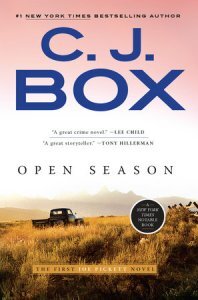 Open Season by C. J. Box
Open Season by C. J. Box
Joe Pickett is the new game warden in Twelve Sleep, Wyoming, a town where nearly everyone hunts and the game warden—especially one like Joe who won’t take bribes or look the other way—is far from popular. When he finds a local hunting outfitter dead, splayed out on the woodpile behind his state-owned home, he takes it personally. Even after the “outfitter murders,” as they have been dubbed by the local press after the discovery of the two more bodies, are solved, Joe continues to investigate, uneasy with the easy explanation offered by the local police.
As Joe digs deeper into the murders, he soon discovers that the outfitter brought more than death to his backdoor: he brought Joe an endangered species, thought to be extinct, which is now living in his woodpile. But if word of the existence of this endangered species gets out, it will destroy any chance of InterWest, a multi-national natural gas company, building an oil pipeline that would bring the company billions of dollars across Wyoming, through the mountains and forests of Twelve Sleep. The closer Joe comes to the truth behind the outfitter murders, the endangered species and InterWest, the closer he comes to losing everything he holds dear. (This novel is part of a new Spectrum series on game warden Joy Pickett.)
Real Issue: While it is illegal to introduce wolves into Maine, there is work to identify wolf sitings. Protection would not happen without a pack being present. And find the Maine Wolf Coalition.
**********************
I’ve written two murder mysteries that also dig into truths.
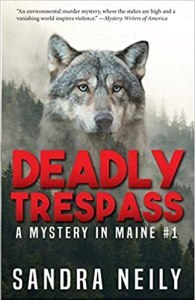 Deadly Trespass
pulls the endangered species issue into threats to Maine’s forests. In this excerpt the narrator frees wolves that have been caught and caged.
Deadly Trespass
pulls the endangered species issue into threats to Maine’s forests. In this excerpt the narrator frees wolves that have been caught and caged.
I hobbled into the barn. Caught in mid-howl, the wolves froze.
“Alright, team,” I said, fumbling with the tape on the door. “Your family’s come to pick you up. Everyone ready to go? Be swift out there. Know your poison and your traps. Have lots of pups. It’s OK to eat miniature pets but no retrievers. The words caught as I leaned my face into the mesh. “I am so sorry I thought you could be tools or strategies or policies. Go. Go be wolves.”
 I yanked the gate and dropped to the ground, body curled in fetal, bear-attack position, injured leg twitching. I tried to count small gusts of wolf air that blew by me. Against all rational behavior, I lowered my arms. Mekong’s yellow dagger eyes calmly explored mine. She swung her head toward the barn door, where one pup hung over the sill, waiting.
I yanked the gate and dropped to the ground, body curled in fetal, bear-attack position, injured leg twitching. I tried to count small gusts of wolf air that blew by me. Against all rational behavior, I lowered my arms. Mekong’s yellow dagger eyes calmly explored mine. She swung her head toward the barn door, where one pup hung over the sill, waiting.
I grinned. You’re welcome.
Don’t mess with us again.
I hope someday I get to see you running wild in the woods.
Don’t count on it.
She sprang at the door and butted her child out of sight. I stumbled into the field to watch a yowling, wagging, licking family reunion over the deer carcass.
The Real Issue: Montana has made killing wolves easier. Some hunters are pushing back. (nationalgeographic.com)
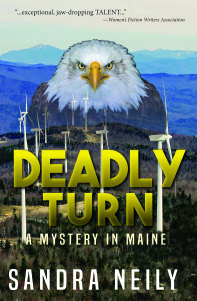 Deadly Turn re-visits Maine’s woods to take a hard looks at eagles, birds, wind power, and carbon reduction opportunities. In this excerpt the narrator’s smart daughter schools her mother on the unexpected.
Deadly Turn re-visits Maine’s woods to take a hard looks at eagles, birds, wind power, and carbon reduction opportunities. In this excerpt the narrator’s smart daughter schools her mother on the unexpected.
Kate’s face brightened. “There’s tons of calculations in forestry. It’s not just boys with axes any more. Folks crunching numbers are all over the place analyzing the forest’s outputs and versatility. I’m headed toward the new stuff. My advisor teaches Climate and Carbon Dynamics and even though I’m not that far along in the program, he lets me audit that class.”
“Smarty-pants,” I said.
“Yup. I am. Your idea about how Maine should appreciate what it has—tons of trees rather than putting industrial energy in remote locations? Well, it didn’t look like you got beyond the public relations thing. It looked like you were working the spin part, but you never got to the math.” She grinned a very wide grin that quickly disappeared. “I’ve got the math. The proof. And most of my notes were in the pack that got stolen.”
“How far did you get?” I asked.
The damselflies were back, this time hooked up in mid-air to mate right in front of us. Kate ignored them. “The math might disappoint some environmental organizations who thought wind power was a climate-change answer for us here. It’s weird. I can run computer models based on real field research. I can show how growing Maine trees and leaving them longer on the land before they’re harvested pulls more carbon from the air than any other carbon reduction strategy we could go for.”
The Real Issue: One of my previous Maine Crime Writers posts takes on the tree, carbon, and get smart issue.
 Deadly Assault, my next Mystery in Maine arrives this year with a body slipped under spring ice, sassy otters, real estate development that’s run amok, a salamander rescue (yes, they’re small, but …) and more threats to Patton and her wayward lab, Pock.
Deadly Assault, my next Mystery in Maine arrives this year with a body slipped under spring ice, sassy otters, real estate development that’s run amok, a salamander rescue (yes, they’re small, but …) and more threats to Patton and her wayward lab, Pock.
 Sandy’s debut novel, “Deadly Trespass, A Mystery in Maine” won a national Mystery Writers of America award, was a finalist in the Women’s Fiction Writers Association “Rising Star” contest, and was a finalist for a Maine Literary Award. The second Mystery in Maine, “Deadly Turn,” was published in 2021. Her third “Deadly” is due out in 2022. Find her novels at all Shermans Books (Maine) and on Amazon. Find more info on Sandy’s website.
Sandy’s debut novel, “Deadly Trespass, A Mystery in Maine” won a national Mystery Writers of America award, was a finalist in the Women’s Fiction Writers Association “Rising Star” contest, and was a finalist for a Maine Literary Award. The second Mystery in Maine, “Deadly Turn,” was published in 2021. Her third “Deadly” is due out in 2022. Find her novels at all Shermans Books (Maine) and on Amazon. Find more info on Sandy’s website.

Writing from Moosehead Lake, ME
Writers & Reviewers, Love & Hate, by Matt Cost
The relationship between writers and reviewers is without a doubt one of love and hate. As I see it, there are four basic types of book reviewers: friends, haters, lovers, and professionals.
The friend is probably the most complicated reviewer of all. It is absolutely mandatory that they write you a good review. Hence, the word friend. But following having done that, a good friend might shoot you an email and suggest some critiques, or even perhaps that the story wasn’t particularly for them.
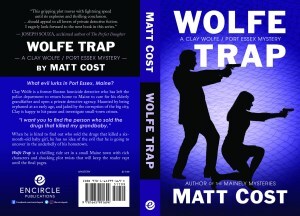
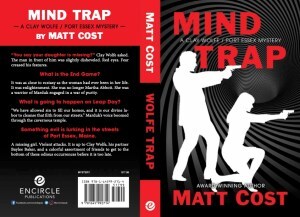
And not every book is for every person. That is why we painstakingly work on the back-cover copy, inside flap description, as well as online retail wording that not only catches the eye of the reader but gives a glimpse of what the book is about.
This leads us to the second type of reviewer. The hater. Many of these fall into the category of free book getters. It is a fact that authors and publishers must give away many free advanced reading copies (ARC) in order to garner reviews and buzz.
Many of these ARCs fall into hands of haters, readers who grasp onto a book just because it’s free, not because they’re interested in the content. This leads to (gasp) them disliking the book. There are many reasons to dislike a book, too many to count, so it’s imperative that the reader make a sound judgement based on the information shared by the author and publisher.
Then there are the misanthropes. The ones with a chip on their shoulder, perhaps failed writers themselves, who go for the jugular. I had one such person read the first three books of my Mainely Mystery series. One star. Two stars. One star. The cardinal rule of writers is to not engage with bad reviews. In this case, I thought it necessary to message them asking them to please STOP READING MY BOOKS.
But the haters, luckily, are cast into their own shadows by the lovers. The stranger in the wild who comes across your book and gives a glowing review, and you feel that warmth generated by this appreciation of the pages that you have labored over and brought into the world to be shared. Many of these strangers become almost friends as they begin to pop up with reviews on other books written by the author.
And then there are the professionals. People who do reviews for a living. Women and men who choose a book because they believe they will like the topic. That it looks interesting. That the byline engages their intellect. They more often then not judge the book not by its cover, but by the contents of its pages. A well written review complimenting one of my books is a wonderful sensation to experience.
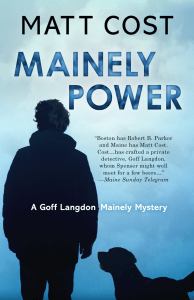
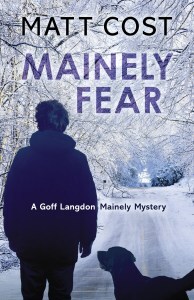
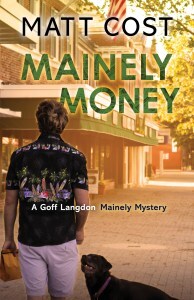
One of my early reviewers is Grace J. Reviewerlady from the U.K. How can I not be happy when she calls MAINELY POWER ‘a cracking good read’? Grace has continued in reviewing my last seven books and makes me smile with every review. She enjoys my plot, characters, and writing. I enjoy reading her reviews.
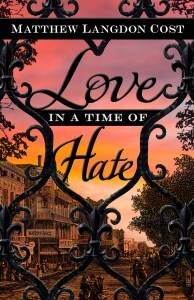 Diane Donovan of the Midwest Book Review did her first review for me on LOVE IN A TIME OF HATE, in which she said: “Love in a Time of Hate‘s ability to juxtapose different forces, special interests, and perspectives against the backdrop of both endings and new beginnings will intrigue and delight historical fiction readers—especially those with a particular affection for Louisiana culture.” How could I feel anything but an affinity and closeness with this woman?
Diane Donovan of the Midwest Book Review did her first review for me on LOVE IN A TIME OF HATE, in which she said: “Love in a Time of Hate‘s ability to juxtapose different forces, special interests, and perspectives against the backdrop of both endings and new beginnings will intrigue and delight historical fiction readers—especially those with a particular affection for Louisiana culture.” How could I feel anything but an affinity and closeness with this woman?
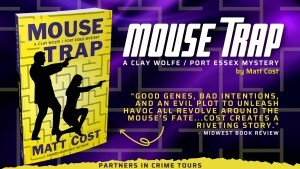
And then there is Terri of BooklyMatters who grasps the innards of my books better than any other reader out there. I’ve pondered getting her to write my back-cover copy for me as she’d probably do a better job. “Clay Wolfe, the nattily-dressed, roguishly-charming, ex-Boston-homicide-cop-turned-PI, is unfurling – expanding his reach (both emotionally and professionally) into thornier, darker, and more challenging arenas – a fascinating budding shift for this already top-notch PI crime series.”
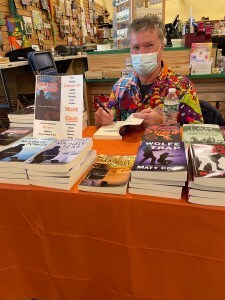
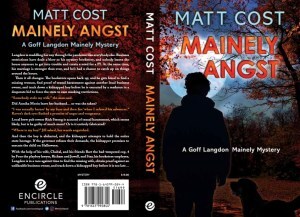
The takeaway is that there are always going to be haters out there. Luckily, they are mostly banished by the warmth of the friends, lovers, and professionals.
Write on.
April 22, 2022
Weekend Update: April 23-24, 2022
 Next week at Maine Crime Writers there will be a posts by Matt Cost (Monday) Sandra Neily (Tuesday), Maureen Milliken (Thursday) and Dick Cass (Friday).
Next week at Maine Crime Writers there will be a posts by Matt Cost (Monday) Sandra Neily (Tuesday), Maureen Milliken (Thursday) and Dick Cass (Friday).
In the news department, here’s what’s happening with some of us who blog regularly at Maine Crime Writers:
An invitation to readers of this blog: Do you have news relating to Maine, Crime, or Writing? We’d love to hear from you. Just comment below to share.
And a reminder: If your library, school, or organization is looking for a speaker, we are often available to talk about the writing process, research, where we get our ideas, and other mysteries of the business. We also do programs on Zoom. Contact Kate Flora
April 21, 2022
Earth Day
On this Earth Day, April 22nd, I look back to the very first Earth Day – what triggered it, what happened where, and what it was like.
The year was 1970 and pollution was widespread. Cities like New York were shrouded in deadly smog and many rivers a polluted mess. Cleveland’s Cuyahoga River literally burned.


Rachel Carson’s Silent Spring, had educated readers about the dangers of pesticides, including DDT. Her outraged followers and many others took to the streets.
As an environmental student at Boston University I certainly remember the first Earth Day. Streets in Boston, New York, and elsewhere were packed with protestors chanting “Give Earth A Chance” and “Respect Your Mother”. Many were the same folks who’d protested the ongoing Vietnam War which didn’t end until 1975. It was a heady time.
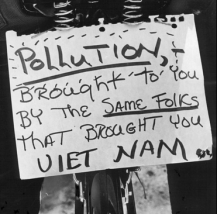 One hopeful sign was the Clean Water Act signed by President Nixon in 1970. William Ruckelshaus was the first Environmental Protection Agency (EPA) administrator. EPA grew into a huge organization of engineers, scientists, environmental protection specialists, and others. Since my brother Tom worked in Boston’s EPA office for twenty-odd years I am based, but EPA’s air and water quality, chemical and toxics, and other programs have been pretty successful despite ongoing political, business, etc. pressures.
One hopeful sign was the Clean Water Act signed by President Nixon in 1970. William Ruckelshaus was the first Environmental Protection Agency (EPA) administrator. EPA grew into a huge organization of engineers, scientists, environmental protection specialists, and others. Since my brother Tom worked in Boston’s EPA office for twenty-odd years I am based, but EPA’s air and water quality, chemical and toxics, and other programs have been pretty successful despite ongoing political, business, etc. pressures.
Despite these and other successes, our environmental future looks pretty dark to me. I wish I could say otherwise.
The  dramatic linear increase in carbon dioxide and other greenhouse gases is shocking. Since 1970, carbon dioxide emissions have increased by about 90%. Emissions from fossil fuel combustion and industrial processes contributed
dramatic linear increase in carbon dioxide and other greenhouse gases is shocking. Since 1970, carbon dioxide emissions have increased by about 90%. Emissions from fossil fuel combustion and industrial processes contributed
On this Earth Day roughly 80% of the total greenhouse gas emissions increase since 1970. Agriculture, deforestation, and other land-use changes are the second-largest contributors.
I’ll not end this piece on a downer. In Maine, Earth Day promises to be a gorgeous spring day. I suggest we take some time outdoors to listen to recently arrived birds, touch a couple of venerable tress, and breath in the lovely spring air.
Lea Wait's Blog
- Lea Wait's profile
- 509 followers



